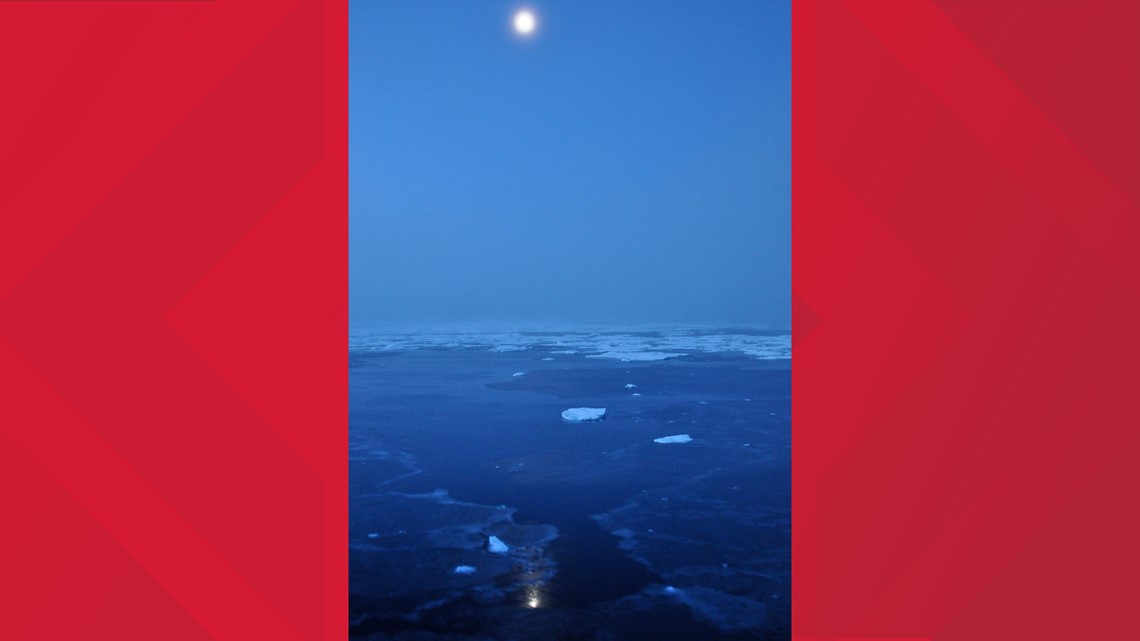A viral video with over 7 million views claimed to depict how the moon appears over the North Pole. In the video, which was posted April 26, a gigantic moon can be seen rising and setting across the horizon in about 30 seconds.
Reactions to the popular video were mixed. Some people asked if the video was real, others attempted to debunk it and still others made jokes about it, saying the video was obviously fake.
THE QUESTION
Does this video depict what the moon looks like at the North Pole?
THE SOURCES
- TikTok account of CGI artist and original video creator LaryLoo
- Mark Serreze, director of the National Snow and Ice Data Center who has done field work in the Arctic
- Photo of the moon from the U.S. Geological Survey (USGS)
- Old Farmer’s Almanac
- National Oceanic and Atmospheric Administration (NOAA)
- North Pole 2015 webcam pictures
THE ANSWER
No, this video does not depict what the moon looks like at the North Pole.
WHAT WE FOUND
This video of the moon was first posted in May 2021 by LaryLoo, a CGI artist on TikTok, who uploaded the video to YouTube a few weeks later. LaryLoo posted a similar video claiming to show Saturn passing directly over the Earth in May 2021 — an event that did not happen.
In the viral lunar video, the moon rises above the horizon at one end of the sky and falls below the horizon at the other end of the sky in about 30 seconds. The moon in the video appears many times larger than it normally does, and appears to cause an eclipse that lasts five seconds as it passes over the sun before setting. The entire scene takes place in the sky over a plain of grassland.
People on social media began sharing the video elsewhere as early as May 2021, with some claiming it showed a solar eclipse at the North Pole. Mark Serreze, director of the National Snow and Ice Data Center who has done field work in the Arctic, says there are multiple reasons why that's not true.
“Fake. First of all, the North Pole is ocean, not land as shown here,” Serreze said.
The National Oceanic and Atmospheric Administration (NOAA) agrees. On its website, NOAA explains that there is only ice floating on top of the Arctic Ocean on the North Pole. The University of Washington placed webcams at the North Pole in 2015; photos from those webcams show a sheet of ice — no grass like the video shows.
“Second, the perspective is all wrong,” Serreze continued. “The moon subtends about 1/2 a degree, someone looks to have supervised a highly magnified moon against an unmagnified land. The moon in the Arctic just looks like the moon.”
That half a degree Serreze mentioned refers to the size of the moon. Astronomers measure the size of celestial bodies as they appear on Earth by the size of the angle they take up in the night sky. If the sky is 180 degrees from horizon to horizon, a full moon is always half a degree.
A photo from the U.S. Geological Survey (USGS) of the moon hovering over the Arctic Ocean on Sept. 10, 2009 shows that the moon doesn’t look any bigger near the North Pole than it does anywhere else.


Even on the horizon, where the moon can appear slightly bigger than usual because of an optical illusion, the moon doesn’t look nearly as big as shown in the video. A photo of the moon taken in Greenland by a Russian travel photographer shows how the moon appears when on the horizon.
Notably, the moon in the video retains a consistent, massive size from the moment it first appears above the horizon all the way until it disappears below the horizon again.
Serreze says another reason why the viral video is fake is the timing of the solar eclipse featured.
“Also, and critically, solar eclipses occur during the new moon!” Serreze said. “Not the full moon!"
The moon in the viral video is a full moon — that’s when the full face of the moon facing Earth is visible from the sun’s illumination. When the moon is new, none of the face is visible from the Earth — making it appear black against the night sky and difficult or impossible to see. Full moons occur when the moon is on the opposite side of Earth from the sun, while new moons occur while the moon is on the same side of Earth as the sun.
The rising and setting of the moon doesn’t happen in such a quick pattern during Arctic summers, either; the moon takes just as long to rise and set there as it does anywhere else in the world. The Old Farmer’s Almanac says the moon rose at 6:03 a.m. and set at 7:25 p.m. in Utqiagvik, Alaska (formerly Barrow, Alaska) on May 8, 2021, the same month the video was first posted online. Utqiagvik is the northernmost town in the U.S. and one of the closest towns in the world to the North Pole.
Finally, the person who most recently tweeted the video later tweeted that they were laughing at the replies to the video, adding that “some people need to lighten up” and that it was a “clever” clip.
It’s not the first time people have falsely spread the claim that the moon appears massive at the North Pole. A separate photo that has circulated since at least 2006 shows a massive moon just over the sun at sunset — supposedly at the North Pole. The photo was created using digital landscape editing software and has been debunked by NASA and numerous fact-checks over the years. Still, from time-to-time, people share the photo as a real photo taken from the North Pole, and it spread again in 2011 and 2015.
More from VERIFY: No, a pink moon doesn’t actually look pink

